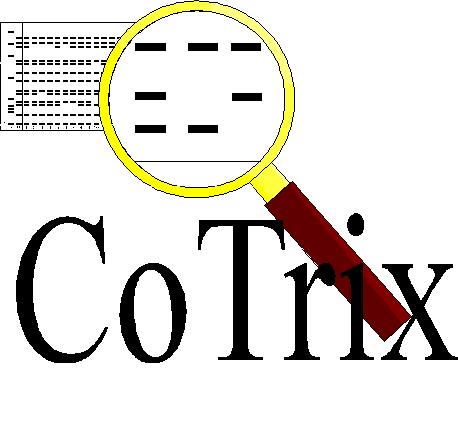 |
Development, optimisation
and validation of molecular tools for assessment of biodiversity in forest
trees
Molecular Tools for Biodiversity |
 |
|---|
 |
Development, optimisation
and validation of molecular tools for assessment of biodiversity in forest
trees
Molecular Tools for Biodiversity |
 |
|---|
Final Compendium of the Research Project
Software for inheritance analysis
|
|
|
|
|
|
Software for modelling of genetic processes
|
|
|
Software for assessing genetic variation
|
|
Software tools
|
|
Developed by: Bernd Degen
Institut für Forstgenetik und Forstpflanzenzüchtung,
Bundesforschungsanstalt für Forst- und Holzwirtschaft,
Grosshansdorf,
Germany
Present address: INRA, Station de Recherches Forestières,
Kourou, Guyane Française
 CoTrix Version 3.0 for Windows NT V.4.0 and
Windows 95
CoTrix Version 3.0 for Windows NT V.4.0 and
Windows 95
CoTrix is an interactive user-friendly computer programme for
analysis of complex DNA banding patterns. The windows programme was developed
for the following tasks:
CoTrix V. 3.0 is written in Visual Basic V. 5.0 (Professional Edition) and has been compiled as 32 bit versions for the operating system Windows 95/98 and Windows NT.
Necessary hard- and software:
|
|
[Download CoTrix at http://kourou.cirad.fr/genetique/software.html] |
Developed by: Elizabeth Gillet
Institut für Forstgenetik und
Forstpflanzenzüchtung, Universität Göttingen,
Göttingen, Germany
The computer program HAPLOGEN performs qualitative inheritance analysis
of zymograms and DNA electropherograms observed in haploid gametophytes.
Input consists of the banding patterns, encoded as lists of 0´s
and 1´s, of a genetically closed sample of gametophytes, i .e., the
sample contains all possible banding patterns that can result as interlocus
combinations of the alleles in the sample. Although genetic closure can
only be judged after completion of inheritance analysis, certain sampling
strategies increase the chances for genetic closure. DIPLOGEN systematically
generate all hypotheses for the mode of inheritance of these patterns that
conform to qualitative rules for the genetic interpretation of single bands.
These rules follow from the concept of "transmission homology" (Gillet,
Silvae Genetica 45, 8-16, 1996).
|
|
[Download HAPLOGEN at http://www.uni-forst.gwdg.de/forst/fg/index.htm] |
Developed by: Elizabeth Gillet
Institut für Forstgenetik und
Forstpflanzenzüchtung, Universität Göttingen,
Göttingen, Germany
The computer program DIPLOGEN performs qualitative inheritance analysis
of zymograms and DNA electropherograms observed in diploid individuals.
Input consists of the banding patterns, encoded as lists of 0´s
and 1´s, of a genetically closed sample of diploid individuals, i
.e., the sample contains all possible banding patterns that can result
as interlocus combinations of the alleles in the sample. Although genetic
closure can only be judged after completion of inheritance analysis, certain
sampling strategies increase the chances for genetic closure. DIPLOGEN
systematically generate all hypotheses for the mode of inheritance of these
patterns that conform to qualitative rules for the genetic interpretation
of single bands. These rules follow from the concept of "transmission
homology" (Gillet, Silvae Genetica 45, 8-16, 1996).
|
|
[Download DIPLOGEN at http://www.uni-forst.gwdg.de/forst/fg/index.htm] |
Johan Peleman, Keygene n.v., Wageningen, The Netherlands
The AFLP® Image Analysis Software is developed for the possibility to analyze AFLP® patterns co-dominantly. Therefore a lot of effort has been put into the characterization of the bands with respect to the exact size, exact intensity and shape. A combination of semi-automatic lane tracking and good quality gels will enable you to do so with the co-dominant package. Automation in lane alignment and automation in the positioning of markers allows a fast, efficient, reliable and accurate analysis, which is currently not met by other packages. Samples extending one image can be jointly analyzed as well.
Whereas many other available software packages will help you to analyze fingerprint images, they are not able to deal with the many data generated by AFLP® fingerprinting in a reliable and efficient way. The AFLP® Image Analysis Software is developed for this purpose and utilizes information intrinsic in an AFLP® pattern for reliable analyses. Reliable co-dominant scoring has not been proven by other packages yet.
The currently available package allows dominant scoring (presence/absence of bands). This package can be upgraded with the co-dominant module for the determination of hetero- and homozygosity (available early in the year 2000).
For more information contact http://www.keygene-products.com
Developed by: Bernd Degen
Institut für Forstgenetik und Forstpflanzenzüchtung,
Bundesforschungsanstalt für Forst- und Holzwirtschaft,
Grosshansdorf, Germany
Present address: INRA Station de Recherches Forestières,
Kourou cedex, Guyane Française
 Eco-Gene
Eco-Gene
For a comprehensive evaluation of human influences on the genetic system, the simulation model Eco-Gene was developed. The model combines population genetic and population dynamic processes with forest growth models. The dynamics of genetic structures (single locus and multilocus genotypes up to 200 loci) can be simulated. Spatial and temporal genetic dynamics with respect to several population genetic processes are included in the model. Overlapping or separated generations can be created and different modes of mating systems can be implemented. The model can be run with empirical and fictitious input data. The simulated genetic structures can be directly analysed with established genetic analysis programmes.
Eco-Gene has been developed with the following general tasks:
Eco-Gene is written in Visual Basic V. 4.0 and Visual Basic V.5.0 (Professional Edition) and has been compiled as 16 and 32 bit versions for the operating system Microsoft Windows 3.1., Windows 95/98 and Windows NT.
Necessary hard- and software:
|
|
[Download Eco-Gene at http://kourou.cirad.fr/genetique/software.html] |
Developed by: Antoine Kremer, Stephanie Mariette
INRA, Laboratoire de Génétique
et d'Amélioration des Arbres Forestiers, Pierroton, France
The evolution of diversity is simulated within
a set of populations exchanging genes and undergoing various evolutionary
scenarios.
|
|
Not yet available for downloading |
GSED -
software for assessing genetic variation
Developed by: Elizabeth Gillet
Institut für Forstgenetik und
Forstpflanzenzüchtung, Universität Göttingen,
Göttingen, Germany
The computer program GSED ("Genetic Structures from Electrophoresis
Data") characterizes genetic structures in population genetic investigations
by calculating measures of genetic variation.
It is based on a conceptually and mathematically unified system
of data analysis.
Measures are calculated for the following genetic structures, input as single- or multilocus absolute frequency distributions:
| Single locus frequencies | Allele frequencies among maternal contributions* |
| Allele frequencies among paternal contributions* | |
| Allele frequencies | |
| Genotype frequencies | |
| Multilocus frequencies | Haplotype frequencies among maternal contributions* |
| Haplotype frequencies among paternal contributions* | |
| Haplotype frequencies | |
| Genotype frequencies |
| Analysis of allelic, haplotype and genotype structures |
| Measures of variation within samples |
| - Diversity v |
| - Total population differentiation deltaT |
| - Evenness e |
| Measures of variation between samples |
| - Genetic distance d0 |
| - Subpopulation differentiation Dj and delta |
| - Test of homogeneity |
| Analysis of genotypic structure |
| - Heterozygosity, single locus and multilocus |
| - Test of Hardy-Weinberg structure and heterozygosity |
| - Test of product structure |
| Analysis of the gene pool |
| Measures of variation within samples |
| - Diversity v of the gene pool |
| - Diversity vgam of the hypothetical gametic output |
| - Total population differentiation deltaT of the gene pool |
| Measures of variation between populations |
| - Distance d0 between gene pools |
| - Differentiation Dj and delta of subdivided gene pools |
|
|
[Download GSED at http://www.uni-forst.gwdg.de/forst/fg/index.htm] |
Developed by: Ingo Hohmann and Ronald Bialozyt
Institut für Forstgenetik und Forstpflanzenzüchtung,
Bundesforschungsanstalt für Forst- und Holzwirtschaft,
Grosshansdorf, Germany
GeneKonv is a software tool allowing conversion between the formats
of input data files for several common genetic data analysis programs,
including BIOSYS, POPGENE, and GSED.
|
|
[Download GeneKonv at http://www.rrz.uni-hamburg.de/OekoGenetik/welcome.htm] |
© Institut für Forstgenetik und Forstpflanzenzüchtung, Universität Göttingen, 1999